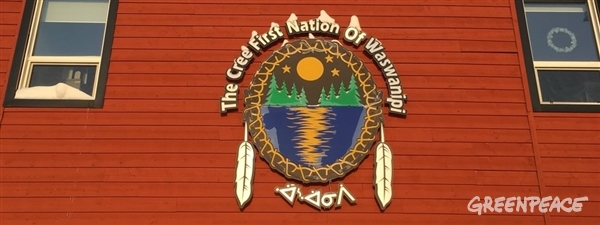January 3, 2018.
New year, new adventure. And what better (do I mean colder?) time to visit the Boreal Forest.

As a forest campaigner, friends often ask me: what is it that you do exactly? Are you one of those people who approaches me in the metro to ask “Do you have a minute…”, while I pretend to be on my phone?
Not quite.
On a day-to-day basis, Forest Campaigners work closely with governments, industry and Indigenous communities to raise awareness across the country on the importance of protecting the Boreal Forest.
We build long-term solutions for the forest and those who live in it and work to to ensure the survival of threatened species like the Woodland caribou.
One of the best parts of my job though is when I get to meet the people who live in the forest and are also actively working to protect it, like the Cree First Nation of Waswanipi.
So when the occasion presented itself to travel to Waswanipi and visit the Broadback River Valley in the Boreal Forest, one of the last forests to remain unlogged in the Cree territory, I immediately jumped on it.
After a day of travelling, we finally arrived. Waswanipi is a Cree community in central Quebec, located over 700 kilometres north of Montréal, with a population of about 1,400.
The word “waswanipi” is usually translated as the “reflection on the water”.
The lands and territories of the Crees in Quebec (Eeyou Istchee) has been heavily impacted by the logging industry and now 90% of the Waswanipi Cree land has been either logged or affected by mining industries. Now they are fighting to protect the last 10% of the forest that remains in its natural state, untouched by industrial disturbance. These old growth forests are precisely the types of habitat the threatened woodland caribou need to survive. Left intact, these forests also retain an amazing capacity to store carbon, thus helping fight climate change.
Friends poke fun at me and call me a professional tree hugger, but a forest is so much more than just its trees.
When the Waswanipi talk about the importance of the land to their way of life and worry about the increased logging and road building of the forest, it reinforces the importance of protecting this land. It’s their home, their traditional lifestyle, their forest, that they are seeking to preserve. An Indigenous Cultural Landscape. Not only for them, but for their grandchildren as well. If that’s not worth fighting for, I don’t know what is.
Tomorrow we head out to visit The Broadback, one of the last intact forests in the Cree territory. After a warm welcome and a good night sleep, I’m ready.
Related articles:
